Foreign newspaper spills the beans: Myanmar-Sri Lanka rice deal smells of corruption
Posted on March 15th, 2022
Courtesy The Daily Mirror
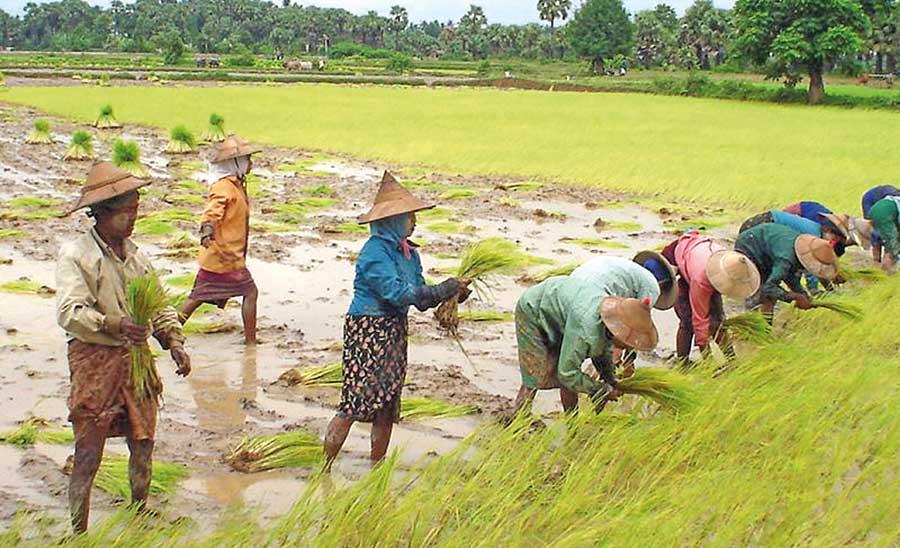
Myanmar uses 70% of chemical fertilizer during the monsoons and 100% of such fertilizer during the dry weather
- Sri Lanka’s pride has taken a beating because it has gone to the extent of obtaining loans from Bangladesh and importing rice from Myanmar
- The Government of Sri Lanka (GoSL) has paid 3.05 billion rupees more than what other countries pay to import rice from Myanmar, The Global New Light reported
- The newspaper article also reported that the exported rice was of low quality
- Reportedly, 100,000 MT of white raw rice and 50,000 MT of parboiled rice are to be imported to Sri Lanka
Focusing on the current plight of the paddy industry in Sri Lanka which runs back to 2600 years ago is a timely requirement. History bears evidence of a rich paddy cultivation existing in the country during the time Prince Vijaya arrived in the island. Sri Lanka was known as the Granary of the East during King Parakramabahu’s time because of the fertile paddy fields. Former Director of Agriculture K. B. Gunaratne said that more than 3000 varieties of paddy were cultivated back then.
requirement. History bears evidence of a rich paddy cultivation existing in the country during the time Prince Vijaya arrived in the island. Sri Lanka was known as the Granary of the East during King Parakramabahu’s time because of the fertile paddy fields. Former Director of Agriculture K. B. Gunaratne said that more than 3000 varieties of paddy were cultivated back then.
The annual rice consumption of Sri Lanka per person is 120 kilograms, but it has reduced to 85-90 kilograms by now. Myanmar is known to produce golden rice which contains B Carotene. Old paddy varieties of Sri Lanka contained similar nutrients, but the local political authority has ruined such varieties, – Former Director of Agriculture K. B. Gunaratne”
At present people are starving and even forced to take their own lives because they’ve failed at feeding their children. Sri Lanka’s pride has taken a beating because it has gone to the extent of obtaining loans from Bangladesh and importing rice from Myanmar.
 The global rice requirement depends on the population and economic growth of Asian and African countries. It has increased from 439 million MT to 496 million MT during the period from 2010-2020. Considering the rice requirement in 2010, it is likely to increase to 555 million MT by 2035; a 26% increase than 2010. It is calculated that farmers will have to produce an additional 8-10 MT of paddy annually,” said Gunaratne.
The global rice requirement depends on the population and economic growth of Asian and African countries. It has increased from 439 million MT to 496 million MT during the period from 2010-2020. Considering the rice requirement in 2010, it is likely to increase to 555 million MT by 2035; a 26% increase than 2010. It is calculated that farmers will have to produce an additional 8-10 MT of paddy annually,” said Gunaratne.
In the past Myanmar did not hold a stable position in producing rice, but over a period of time it became the most prominent rice exporter in the world; exporting 631000 MT of rice annually. Myanmar toiled for a decade to uplift rice production and followed policies to increase the use of lands, water resource management, infrastructure and
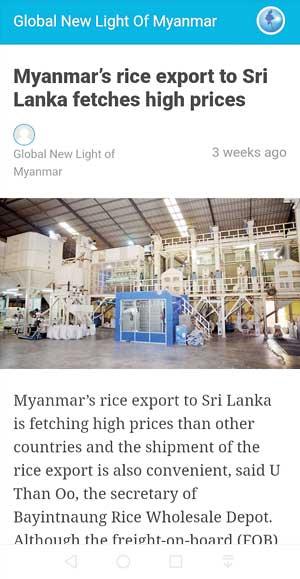 A website report of the rice deal that features Sri Lanka and Myanmar A website report of the rice deal that features Sri Lanka and Myanmar |
harvest. Myanmar did not forsake agricultural policies because of a mere comment given by a monk or a doctor and was not strict on following an organic agricultural policy. It did not dream of increasing its harvest by 100%; with or without fertilizer. Myanmar was strict on pursuing one goal and the single policy it had to ensure success was to implement a 10-year plan.
In areas receiving monsoon rains in Myanmar paddy is cultivated in 5.7 million hectares of land. During the dry weather, roughly 5.7 million hectares of land are cultivated. The annual rice consumption in Myanmar is 160-208 kilograms per person. Myanmar is one of the most rice consuming countries in the world. The annual rice consumption of Sri Lanka per person is 120 kilograms, but it has reduced to 85-90 kilograms by now. Myanmar is known to produce golden rice which contains B Carotene. Old paddy varieties of Sri Lanka contained similar nutrients, but the local political authority has ruined such varieties,” said Gunaratne.
In a country where ministers boast of similar feats as King Parakramabahu farmers have lost all their incomes and are forced to protest and demand fertilizer and seeds,” Gunaratne said.
150,000 MT of rice is to be imported ruining the rice production in the upcoming Yala season. Politicians and officials import rice for the commission and such imported rice stocks are eventually sold as animal feed or else the rice sold as animal feed is polished and sold back as good rice, – Anuradha Thennakoon Jathika Govijana Ekamutuwa Chairman”
The Global New Light, a popular newspaper in Myanmar, recently revealed that several people in Sri Lanka had sought a commission for the stock of rice ordered from Myanmar. This article received much attention in the country. The Government of Sri Lanka (GoSL) has paid 3.05 billion rupees more than what other countries pay, The Global New Light reported. According to the agreement signed between the two countries the export price of rice to Sri Lanka is 440-450 USD per MT, but according to the newspaper the price of rice exported to other countries is between 340-350 USD per MT.
Accordingly, Sri Lanka pays 100 USD additionally per MT which is 20300 rupees. Sri Lanka is to import 150,000 MT of rice.
The newspaper article also reported that the exported rice was of low quality. Myanmar uses 70% of chemical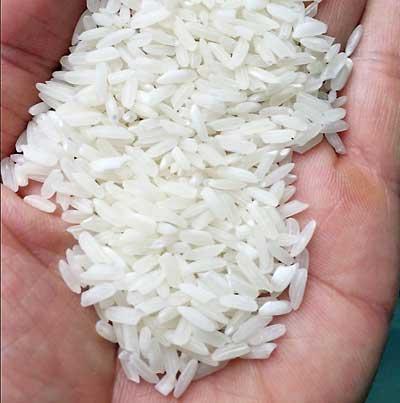 fertilizer during the monsoons and 100% of such fertilizer during the dry weather. Compared to countries like Indonesia, Philippines, Thailand, Bangladesh, Vietnam and Cambodia, Myanmar uses less chemical fertilizer. But when producing paddy with an increased harvest, the use of chemical fertilizer is 100%, according to Gunaratne.
fertilizer during the monsoons and 100% of such fertilizer during the dry weather. Compared to countries like Indonesia, Philippines, Thailand, Bangladesh, Vietnam and Cambodia, Myanmar uses less chemical fertilizer. But when producing paddy with an increased harvest, the use of chemical fertilizer is 100%, according to Gunaratne.
Myanmar also uses pesticides to a large extent. Paddy cultivation in Myanmar is mostly affected by 29 insects. Rice blight is mostly found in Myanmar. Therefore pesticides are used both minimally and excessively. Farmers in Myanmar take advice on pesticides from traders. These traders recommend a product that gives them the highest commission. Media reports from Myanmar regarding the quality of exported rice should receive more attention from Sri Lankan officials,” Gunaratne said.
Those who are behind the garlic scam, water bottle scam and biscuit scam can be behind this Myanmar rice deal. Even on March 15- the World Consumer Rights Day-the authorities will make sure that Sri Lankans are in the dark or in queues. There is no end to this matter, – Asela Sampath, Foundation for People’s Rights Protection Chairman”
U Than Oo, Secretary of Bayintnaung Rice Wholesale Depot, said that rice would be exported for 2022 and 2023. Reportedly, 100,000 MT of white raw rice and 50,000 MT of parboiled rice are to be imported to Sri Lanka. Sri Lanka is to pay an additional 15 million US$ hence one needs to investigate whether that is the commission going into the hands of people involved in this deal. Attempting to obtain commission when most people are without electricity and gas is a huge crime. That commission in Sri Lankan rupees is 3.04 billion, according to the news article,” said Gunaratne.
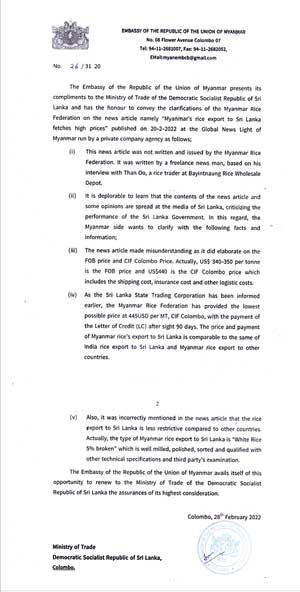 The letter issued by the Myanmar Embassy The letter issued by the Myanmar Embassy |
The son of a minister and a top official of Sri Lanka State Trading Corporation (STC) were accused directly regarding their involvement in obtaining commissions through this deal. A STC spokesperson said that some documents regarding the deal had already been displaced.
Jathika Govijana Ekamutuwa Chairman Anuradha Thennakoon said that only 15,000 MT of rice is imported annually according to the rice requirement of the country. This is done without affecting the paddy price during the two seasons-Yala and Maha- with the hope of regulating the price of rice during shortages. However 150,000 MT of rice is to be imported ruining the rice production in the upcoming Yala season. Politicians and officials import rice for the commission and such imported rice stocks are eventually sold as animal feed or else the rice sold as animal feed is polished and sold back as good rice,” Thennakoon added.
We cannot completely ignore what the Myanmar media had reported,” Chairman of the Foundation for People’s Rights Protection, Asela Sampath said. Those who are behind the garlic scam, water bottle scam and biscuit scam can be behind this Myanmar rice deal. Even on March 15- the World Consumer Rights Day-the authorities will make sure that Sri Lankans are in the dark or in queues. There is no end to this matter. They keep obtaining commission in the guise of granting concessions to people,” he added.
Secretary to the ministry of Trade Bhadrani Jayawardena could not be contacted. A spokesperson of the Ministry of Trade said that the news article from Myanmar was baseless. Rice is not exported for such low prices. The article does not mention any details of any such deal. The price of rice has increased compared to the price in 2019. With the increase in shipping cost, the price of one MT of rice was discussed to be 490 US$, but we could reduce the price to 440 US$. I can answer if accusations can be proven,” she added.
Trade Minister Bandula Gunawardana could not be contacted.
Attempting to contact Sri Lanka State Trading (General) Corporation (SLSTC) Chairman Yoga Perera proved futile. An officer of the SLSTC responding to our queries said that Perera was not in his office on Monday, had attended an urgent meeting on Tuesday and was absent on Wednesday. The Chairman does not come to the office every day,” he added. The Chairman did not call back despite this officer taking our number.
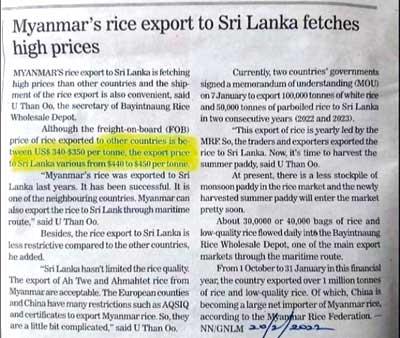
The newspaper report that appeared in The Global New Light
Rice is not exported for such low prices. The article does not mention any details of any such deal. The price of rice has increased compared to the price in 2019. With the increase in shipping cost, the price of one MT of rice was discussed to be 490 US$, but we could reduce the price to 440 US$, – Spokesperson Ministry of Trade”
Commercial Division of the Myanmar Embassy in Sri Lanka apologises
Despite what the Myanmar media had to say regarding the rice deal the Commercial Division of the Myanmar Embassy in Sri Lanka issuing a statement said there was no issue regarding the quality of rice exported to Sri Lanka and that they could guarantee the quality. The embassy statement contained an explanation from the Myanmar Rice Federation regarding the news article appearing on Global News Light web site. Accordingly the article sporting the headline Myanmar’s rice export to Sri Lanka fetches high prices,” is not published by the federation, but is based on an interview conducted by a freelance journalist with Than O, a rice trader in Bayintnaung Rice Wholesale Depot. We are sorry that this article was used by the media criticizing the Sri Lankan Government. The Myanmar Government will also make an explanation. The newspaper has misunderstood the Free on Board (FOB) price and Cost, Insurance and Freight (CIF) price. 340-350 USD per MT is the FOB price and 440 USD is the CIF-Colombo price and includes the shipping cost, insurance cost and other fees. As informed by Sri Lanka State Trading Corporation, one MT of rice is sold at 440 US$ according to the CIF Colombo price through a Letter of Credit of 90 days. The prices are the same as the rates for other countries.
‘This article is false. Compared to other countries, rice will be exported without disturbances. The rice variety exported to Sri Lanka is 5% broken white raw rice milled and polished properly and its quality is certified by a third party. The embassy can reassure on the quality of rice exported to Sri Lanka,” the statement said.